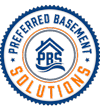Exterior Drainage Systems
 One very important factor to consider when constructing any home is its exterior foundation drainage system or “footing drain”. Some older homes may have actually been constructed without a drainage system. Over time, some drainage systems can possibly fail due to poor workmanship, improper design, cheap materials, or unforeseen natural conditions.
One very important factor to consider when constructing any home is its exterior foundation drainage system or “footing drain”. Some older homes may have actually been constructed without a drainage system. Over time, some drainage systems can possibly fail due to poor workmanship, improper design, cheap materials, or unforeseen natural conditions.
Many homeowners never consider their home’s exterior drainage system until it fails and begins to cause problems in their basement. Proper drainage is imperative to maintaining a dry, clean, and healthy basement as well as avoiding possible future repair expenses. Footing drain failure is one of the most common causes of wet basements as the footing drain is responsible for carrying or “conducting” away any water that accumulates around the foundation. If this footing drain is absent or not functioning properly, then the water is allowed to accumulate and the hydrostatic pressure begins to build.
There are two things that will keep a foundation from leaking:
- A proper waterproofing membrane on the foundation walls.
- A properly installed drainage system
 When soil is not able to drain properly then it becomes saturated. The weight of this saturated soil is what is known as “hydrostatic pressure”. The higher the water is in a vertical column, such as around your home’s foundation, the greater the amount of hydrostatic pressure that will exist. This water pressure against your foundation wall will search for any weak points in your home’s waterproofing, find and manipulate them, and inevitably result in a wet basement. Water is the “Universal Solvent” and will always take the path of least resistance. Water intrusions will generally appear through joints, cracks, or around pipe penetrations. Aside from simply having a wet basement, which can contribute to the growth of mold and cause other moisture related problems, hydrostatic pressure left unresolved actually has the capability of causing structural damage in some situations by pushing the foundation walls inward causing deflection and decreasing their load capabilities. While there are repairs that can be made to arrest and stabilize this deflection, it is crucial to resolve the root cause of the problem. The easiest way to resolve a water penetration issue is with the absence of water in the first place. That’s exactly what an exterior drainage system is designed to do.
When soil is not able to drain properly then it becomes saturated. The weight of this saturated soil is what is known as “hydrostatic pressure”. The higher the water is in a vertical column, such as around your home’s foundation, the greater the amount of hydrostatic pressure that will exist. This water pressure against your foundation wall will search for any weak points in your home’s waterproofing, find and manipulate them, and inevitably result in a wet basement. Water is the “Universal Solvent” and will always take the path of least resistance. Water intrusions will generally appear through joints, cracks, or around pipe penetrations. Aside from simply having a wet basement, which can contribute to the growth of mold and cause other moisture related problems, hydrostatic pressure left unresolved actually has the capability of causing structural damage in some situations by pushing the foundation walls inward causing deflection and decreasing their load capabilities. While there are repairs that can be made to arrest and stabilize this deflection, it is crucial to resolve the root cause of the problem. The easiest way to resolve a water penetration issue is with the absence of water in the first place. That’s exactly what an exterior drainage system is designed to do.
Excavating the Foundation
Your exterior drainage system is actually the last step in your home’s exterior waterproofing as it works in conjunction with other factors and systems for the purpose of keeping your foundation sound and dry. In order to install on existing homes, it is necessary to excavate down to the foundation footers. It is important to ensure that an appropriate damp proofing or waterproofing membrane and protection/ drainage board are applied during this stage of the process while the foundation walls are exposed. The trench is lined with a minimum of 2 inches of washed gravel. A perforated drain pipe is laid in the trench with the perforations facing down on top of the gravel and below the top of the footer. The drain pipe is then covered with an additional 6 to 12 inches of washed gravel topped with a filter fabric membrane.
The filter fabric will prevent any soil from penetrating the free draining bed of gravel which, in turn, will prevent the drain pipe from becoming clogged, rendering it ineffective. The remainder of the trench can then be backfilled to grade using either more washed gravel or clean natural soils. Special attention must be given to ensure that proper grading is established to direct surface water away from the foundation walls. Properly installed, the exterior drainage system or “drain tile” will act as a piping system to collect and conduct away any subsurface water that permeates the soil surrounding your foundation.
At Preferred Basement Solutions, we first consider all factors and possible solutions to your home’s waterproofing concerns before making any recommendations. While an exterior drainage system will most certainly conduct the water away, effectively relieving the hydrostatic pressure, it is time consuming, costly, and intrusive to your yard and landscape. While we generally regard this repair as the last option, in some cases, it is the necessary option in order to facilitate a lasting solution to your waterproofing concerns.
